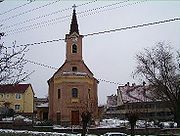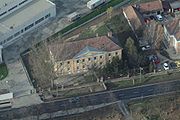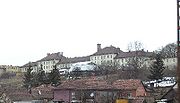
Rétság
Encyclopedia
Location
Rétság is located 55 km (34 mi) north of BudapestBudapest
Budapest is the capital of Hungary. As the largest city of Hungary, it is the country's principal political, cultural, commercial, industrial, and transportation centre. In 2011, Budapest had 1,733,685 inhabitants, down from its 1989 peak of 2,113,645 due to suburbanization. The Budapest Commuter...
on the E77 European main road, halfway between Vác
Vác
Vác is a town in Pest county in Hungary with approximately 35,000 inhabitants. The archaic spellings of the name are Vacz and Vacs.-Location:...
and Balassagyarmat
Balassagyarmat
Balassagyarmat is a town in northern Hungary. It was the seat of the Nógrád comitatus.- History :The town's coat-of-arms bears the Latin inscription "Civitas Fortissima" , because in January 1919 Czechoslovak troops crossed the demarcation line delineated in December 1918 in preparation for the...
. The town is seated at the border of Cserhát
Cserhát
Cserhát is a mountain range in Hungary, part of the North Hungarian Mountains, divided between Pest and Nógrád counties. Its highest point is the Naszály with an elevation of 654 metres above sea level....
and Börzsöny
Börzsöny
Börzsöny is a mountain range in Northern Hungary. Its tallest peak is the Csóványos with 938 metres.It is the westernmost member of the North Hungarian Mountains, which in turn are part of the Inner Western Carpathians. The varied landscape offers good hiking opportunities. A large part of the...
hills. Its location determines the function of the town.
History
The settlement was property of the Losonczy family in 1393, its name was Réthy Saag. The OttomanOttoman Empire
The Ottoman EmpireIt was usually referred to as the "Ottoman Empire", the "Turkish Empire", the "Ottoman Caliphate" or more commonly "Turkey" by its contemporaries...
conquest started in the middle of the 16th century (when castle Nógrád was captured by the Ottoman army) and lasted till the middle of the 17th century. During the Ottoman conquest Rétság became near totally desolated.
Big landowners was in Rétság: Mehmed Daud 1562-1563, Ottoman from liva of Hussein pasha 1566-1567, Bosna Hassan 1583-1584, Gábor Lónyai 1656, Paul Sréter and his family 1770, widow count Mrs. Béla Benyovszky, Sándor Rosenbach, Frigyes Herzfeld in 1910.
The St. Andrew Roman Catholic church was built in 1726. The railway connection and the railway station was built in 1908. Presidential Council of Hungarian People’s Republic
Hungary
Hungary , officially the Republic of Hungary , is a landlocked country in Central Europe. It is situated in the Carpathian Basin and is bordered by Slovakia to the north, Ukraine and Romania to the east, Serbia and Croatia to the south, Slovenia to the southwest and Austria to the west. The...
pronounced Rétság to be town in 1989.
Pusztaszántó belongs to Rétság was first mentioned in 1299 and was independent village in 1460. It was desolated during the Ottoman conquest, after it was settled again and the population was larger than in Rétság in the 19th century. Now it has only few inhabitants, but the industrial park of the town is here.
Sights


- St. AndrewSaint AndrewSaint Andrew , called in the Orthodox tradition Prōtoklētos, or the First-called, is a Christian Apostle and the brother of Saint Peter. The name "Andrew" , like other Greek names, appears to have been common among the Jews from the 3rd or 2nd century BC. No Hebrew or Aramaic name is recorded for him...
Roman catholic church built in 1726. - Kovács mansion built in neoclassical style in the beginning of the 19th century in Pusztaszántó.
- Characteristic buildings of the former armoured trooper caserne can be seen from a great distance. The local regiment took place in battles of the Eastern FrontEastern Front (World War II)The Eastern Front of World War II was a theatre of World War II between the European Axis powers and co-belligerent Finland against the Soviet Union, Poland, and some other Allies which encompassed Northern, Southern and Eastern Europe from 22 June 1941 to 9 May 1945...
of World War IIWorld War IIWorld War II, or the Second World War , was a global conflict lasting from 1939 to 1945, involving most of the world's nations—including all of the great powers—eventually forming two opposing military alliances: the Allies and the Axis...
, occupation of CzechoslovakiaCzechoslovakiaCzechoslovakia or Czecho-Slovakia was a sovereign state in Central Europe which existed from October 1918, when it declared its independence from the Austro-Hungarian Empire, until 1992...
in 1968 and was disbanded in 1997 - Grass airfield for microlighters

Famous people
Szabolcs Fényes(1912 Nagyvárad-1986 Budapest), abroad known as Peter Fényes, Hungarian operetta and musical composer and director of the Budapester Operetta Theatre in the 1940s and the 1950s lived in Rétság between 1927 and 1931 and here composed his first celebrated operetta Maya in 1931, which would be played in twelve European countries later.Sights in neighbourhood
- BánkBánk-References:...
: Lake (beach, fishing place, water-stage), every summer nationality festival - NőtincsNotincsNőtincs , a pictorial locality looking back on a thousand-year old history is in Nógrád county, Hungary.The village is located north of Budapest near the European route E77, halfway between Vác and Balassagyarmat. Nőtincs is seated at the border of Cserhát and Börzsöny hills. Its location...
: Lake (fishing place) - DiósjenőDiósjenoDiósjenő is a village in Nógrád county, Hungary. It is surrounded by hills and beautiful landscape.-History:The village was first mentioned in 1282. Its name comes from Jenő, the name of one of the seven tribes conquering present-day Hungary, while the word "diós" refers to walnut trees. The...
: Lake (fishing place), open-air bath - TereskeTereskeTereske is a village in Nógrád county, Hungary.- Parochial church :The most attractive sightseeing in the village is the parochila church. The Tereske parochial church has been built as a Benedictine abbey in romanesque style in the 11. C. A. D. The main sightseeing is the legend of Saint László...
: Romanesque style church built in the 13th century - NógrádNógrádNógrád is a village in Nógrád County, Hungary.- External links :*...
: Spectacular ruins of castle Nógrád, which was the centre of Nógrád county between 11th and 13th centuries and gave the name to the county

